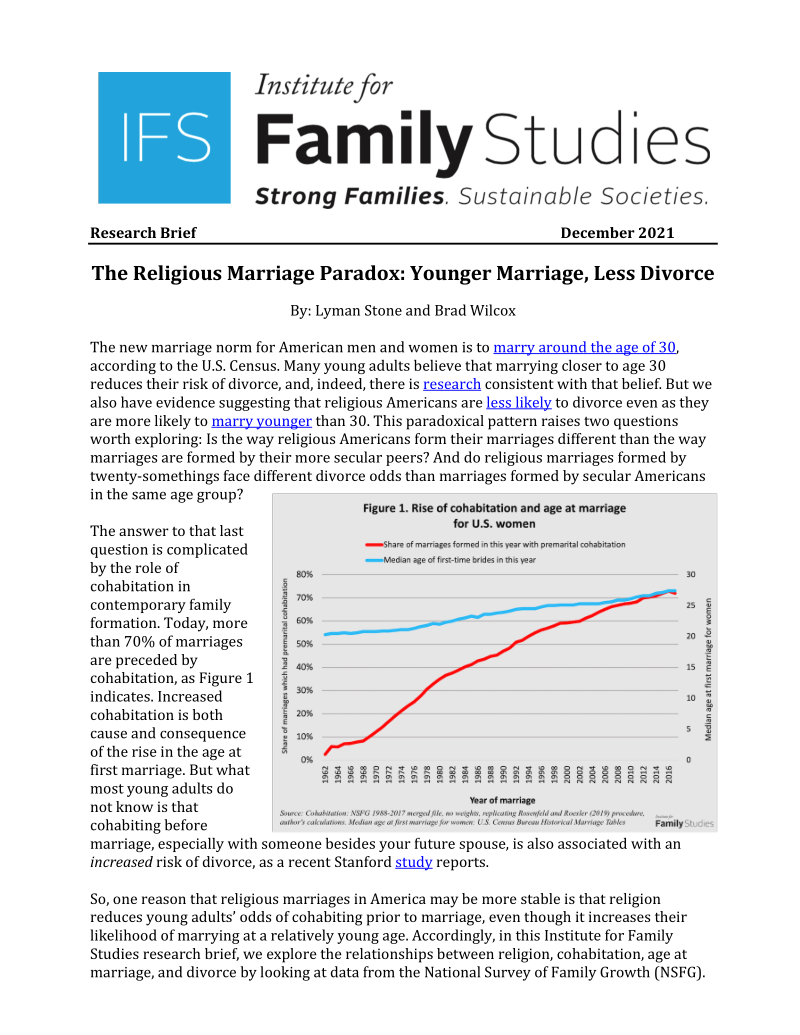Research brief finds that women with religious upbringing are less likely to cohabitate and divorce than those with irreligious upbringing; non-Christian religions (Mormons) even less likely.
- Type
- Academic / Technical Report
- Source
- Institute for Family Studies Non-LDS
- Hearsay
- Secondary
- Reference
Lyman Stone and W. Bradford Wilcox, "The Religious Marriage Paradox: Younger Marriage, Less Divorce," Institute for Family Studies Research Brief, December 2021, 2-5, 7
- Scribe/Publisher
- Institute for Family Studies
- People
- Institute for Family Studies
- Audience
- Reading Public
- Transcription
Figure 2 shows, after incorporating the effects of control variables, that in a typical year of life, about 5% of nonreligious women ages 18-49 who have not yet married or cohabited will begin a cohabiting union. That figure is nearer 4% for women with a Christian upbringing, nearer 3% for women with a non-Christian religious upbringing (i.e., Mormons and Jehovah’s Witnesses as well as Jews, Muslims, Hindus, and others), and about 4% for religious women on the whole. In other words, after controlling for a variety of background factors, women who grew up religious are about 20% less likely to begin a cohabiting union in any given year than their non-religious peers. As a result, by age 35, about 65% of women with a non-religious upbringing had cohabited at least once, versus under 50% of women with a religious upbringing. Not only does religion reduce the odds that young adults cohabit, it also increases the odds that they marry directly, or without cohabiting first.
[Figure 2]
. . . .What we really want to know is: conditional on getting married, do religious people get divorced less?
[Figure 4]
The answer appears to be yes. Without controls for age at marriage or an indicator for premarital cohabitation, women with a religious upbringing do have slightly lower likelihoods of divorce. As shown in Figure 4, the annual divorce rate among married women with a nonreligious upbringing is around 5%. For religious women, it’s around 4.5%. The effect is clearest for Catholic and Mainline Protestant women, and less clear for Evangelical Protestant women. Overall, if we control for basic socioeconomic background and a woman’s educational career trajectory, the typical marriage of a woman with a religious upbringing is about 10% less likely to end in divorce within the first 15 years of marriage than the typical marriage of a woman with a non-religious upbringing.
Adding controls for age at marriage yields about the same results, suggesting that even though religious people get married younger, their divorce rates are still a bit lower. But it may just be that religious people cohabit less, and that is what drives the reduction in divorce. To assess this point, we analyze only marriages with no premarital cohabitation, and find no effect of religion: women with a religious upbringing have about the same likelihood of divorce as other women with the same relationship history and socioeconomic status. Most of the benefit of religiosity in terms of reducing divorce occurs because religious marriages are more likely to be direct marriages, rather than marriages with premarital cohabitation. In other words, one reason that women raised in a religious home are less likely to divorce is that they are less likely to cohabit prior to marrying.
. . . .Our results also suggest that religion fosters relationship stability by pushing young adults away from cohabitation, which is highly unstable, and towards marriage, which is much more stable.
- Citations in Mormonr Qnas
The B. H. Roberts Foundation is not owned by, operated by, or affiliated with the Church of Jesus Christ of Latter-day Saints.

